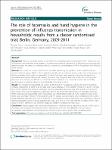The role of facemasks and hand hygiene in the prevention of influenza transmission in households: results from a cluster randomised trial; Berlin, Germany, 2009-2011
Süß, Thorsten
Remschmidt, Cornelius
Schink, Susanne
Schweiger, Brunhilde
Nitsche, Andreas
Schröder, Kati
Döllinger, Jörg
Milde, Jeanette
Haas, Walter
Köhler, Irina
Krause, Gérard
Buchholz, Udo
Background: Previous controlled studies on the effect of non-pharmaceutical interventions (NPI) - namely the use of facemasks and intensified hand hygiene - in preventing household transmission of influenza have not produced definitive results. We aimed to investigate efficacy, acceptability, and tolerability of NPI in households with influenza index patients. Methods: We conducted a cluster randomized controlled trial during the pandemic season 2009/10 and the ensuing influenza season 2010/11. We included households with an influenza positive index case in the absence of further respiratory illness within the preceding 14 days. Study arms were wearing a facemask and practicing intensified hand hygiene (MH group), wearing facemasks only (M group) and none of the two (control group). Main outcome measure was laboratory confirmed influenza infection in a household contact. We used daily questionnaires to examine adherence and tolerability of the interventions. Results: We recruited 84 households (30 control, 26 M and 28 MH households) with 82, 69 and 67 household contacts, respectively. In 2009/10 all 41 index cases had a influenza A (H1N1) pdm09 infection, in 2010/11 24 had an A (H1N1) pdm09 and 20 had a B infection. The total secondary attack rate was 16% (35/218). In intention-totreat analysis there was no statistically significant effect of the M and MH interventions on secondary infections. When analysing only households where intervention was implemented within 36 h after symptom onset of the index case, secondary infection in the pooled M and MH groups was significantly lower compared to the control group (adjusted odds ratio 0.16, 95% CI, 0.03-0.92). In a per-protocol analysis odds ratios were significantly reduced among participants of the M group (adjusted odds ratio, 0.30, 95% CI, 0.10-0.94). With the exception of MH index cases in 2010/11 adherence was good for adults and children, contacts and index cases. Conclusions: Results suggest that household transmission of influenza can be reduced by the use of NPI, such as facemasks and intensified hand hygiene, when implemented early and used diligently. Concerns about acceptability and tolerability of the interventions should not be a reason against their recommendation.
Dateien zu dieser Publikation
Keine Lizenzangabe

